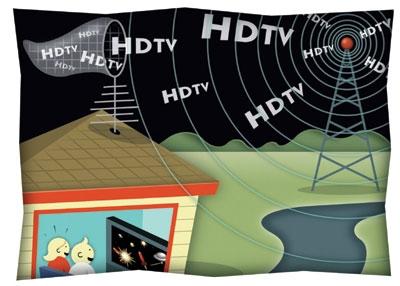HDTV Over the Air

When I got satellite TV installed at my house a few years ago, I had a regular VHF/UHF antenna put in at the same time so that I could receive high-definition TV broadcasts. Over-the-air was the only game in town for HD back then. Now, with the major cable companies embracing high-def, and with satellite-TV services offering more and more high-def channels, HDTV is easier to come by. But satellite and cable can't reach everyone, and the only way a lot of people can get the high-def versions of the major networks is by using an old-fashioned TV antenna.
That's not necessarily bad, though. Once you've paid for the antenna, the programming's free. And as long as you can pull in a strong, clean signal, the picture and sound will be a stunning improvement over anything you've experienced on regular TV.
You'll have no trouble finding all kinds of antennas at big electronics retailers like RadioShack, Circuit City , and Best Buy. The key is to make sure you get the right one and set it up properly - which you can ensure by considering a few basic questions.
What kind of antenna do I need? Most high-def channels are in the UHF band (Channels 14 through 83), and many of the rest are in the VHF high band (Channels 7 through 13). Even if, say, your local ABC station broadcasts regular TV on Channel 2 and lists its HDTV channel as 2-1, it might actually be transmitting it on something like Channel 44. (A good resource for finding out about local high-def channel assignments is antennaweb.org.)
Chances are good that a UHF antenna (about $50 to $85) will work fine if you only want to receive high-def. But if you want VHF, whether for HDTV or regular TV, or you want to use the antenna to pick up FM radio as well (the entire FM band is nestled between TV Channels 6 and 7), get a VHF/UHF/FM antenna (about $35 to $85).
An omnidirectional antenna, which is equally sensitive to signals from all directions, can work well if you live in a flat area that's relatively near the transmission towers for your local stations. But usually, you'll be much better off with a directional antenna aimed at the towers. And if you live near an airport, like I do, a directional antenna can help prevent signal reflections off low-flying planes from disrupting your reception (or at least minimize the problem).
To figure out an antenna's directionality, you need to know the spec for its front-to-back ratio, or the difference between its sensitivity in front and 180° behind. The higher the number in decibels (dB), the greater the directionality, or the more tightly it's focused in one direction. If you can receive HDTV broadcasts from more than one direction but can't go with an omnidirectional antenna, you'll have to get a directional antenna and use a remote-controlled motorized rotor to aim it.























































